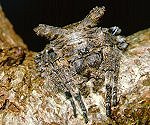|
Genus: Caerostris (bark
spiders)
Life
> Eukaryotes
>
Opisthokonta >
Metazoa
(animals) > Bilateria > Ecdysozoa > Panarthropoda > Tritocerebra >
Arthropoda > Arachnomorpha > Cheliceriformes > Chelicerata > Euchelicerata
> Arachnida > Araneae
> Araneomorpha > Family: Araneidae
Bark spiders are
nocturnal orb-web spiders that construct a large orb web, up to 1.5 metres,
stretching from one tree to the next. The abdomen is
cryptically coloured and adorned with numerous horny projections and viewed from
the rear a definite animal face can be perceived. When she is off her web she
retires to a branch and packs her legs tightly next to her body and she melts
into her surroundings looking like a knot on the branch. This spider is
sometimes referred to as the Winston Churchill spider as in this position the
abdomen with the two projections are reminiscent of a fist with fingers
protruding in victory.
Caerostris are large
spiders with females reaching 30mm in body length. Very few males, which are
tiny, have been collected and no males are known for Caerostris corticosa.
Species indigenous to southern Africa
Four species have been reported from this
region.
Caerostris
corticosa
Caerostris corticosa occurs away from forest and
appears to be an arid to fynbos species found in Botswana, the Northern and
Western Cape with a record for Pretoria. At Grootvadersbos Nature reserve it
was found to be common in burnt fynbos with webs spread between dead
branches about 1.5-2metres above the ground. No spiders were found in the
adjacent forest some 100-200metres away. It was not as common in unburnt
fynbos. The egg sacs has a yellowish tinge and the spiderlings are black.
The adult females were all a dark grey and no males are known. |
|
|
Caerostris mitralis
Caerostris mitralis
is found in Mozambique and Kwazulu/Natal in South Africa. |
|
Caerostris
sexcuspidata
Caerostris sexcuspidata, although nocturnal, can
be found on her web in shaded forested areas during the day. This is the
most widespread species occurring south of the 5° North (central and east
Africa) It is the common species in South Africa and the species with the
most variations in abdomen shape. |
 |
Caerostris vinsonii Caerostris
vinsonii.occurs from central Africa to Botswana, Mozambique and
Kwazulu/Natal in South Africa. |
|
Text and images by Norman Larsen
©. |
